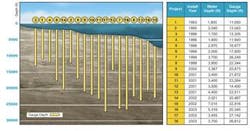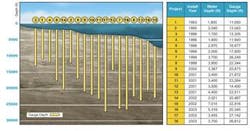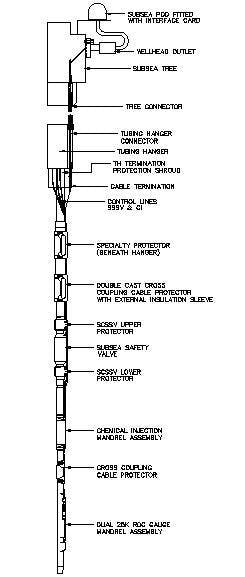Deepwater project marks milestone in downhole readout systems
Shell, Wood Group advance subsea technology
Arno Van Den Haak
Mark Chustz
Shell
Mark Bowman
Wood Group Production Technology
Since 1993, Shell and Wood Group Production Technology have been installing permanent downhole readout (PDR) and chemical injection systems in the Gulf of Mexico. Toward the end of last year, the Princess field development project marked another milestone.
The Princess field is in Mississippi Canyon blocks 765 and 766 in the GoM. Princess has a water depth of 3,700 ft and is tied back to the Ursa TLP. Shell's Princess development set a new GoM record drilling depth of 33,200-ft measured depth.
For Wood Group, the Princess project was the latest in a long line of deepwater subsea GoM projects for Shell. Work began in 1993 with first-generation deepwater PDR systems on the Tahoe, Popeye, and Rocky projects and went on to include 15 subsequent developments. When the first Shell subsea wells with PDR systems, Tahoe and Popeye, were worked over after seven and 10 years, respectively, the PDR systems were still providing pressure and temperature data upon retrieval. Fourth-generation deepwater PDR technology was employed for the Na Kika project in 2002. This included 20,000 psi/160° C (320° F) ROC downhole digital gauges and a 10,000 psi/121° C (250° F) Slimbore subsea connector system.
The Princess project presented new technical challenges and dictated the need for even higher pressure gauges and connector systems. The fifth-generation technology that was installed on Princess, and that will be installed on the Llano project, is the result of a long-term plan to provide reliable systems for the increasing extremes of high-pressure reservoir monitoring in GoM deepwater development projects.
null
Project specifics
In addition to higher temperature-rated subsea connector systems and deeper-set gauges, the Princess project employed Wood Group's new generation of ROC gauges rated for 25,000 psi.
Princess subsea installation schematic.
Specific to Princess and the pending Llano project are:
- ROC 25,000-psi/160° C (320° F) downhole gauges
- Well/gauge setting depths of over 20,000 ft, which required lengths of splice-free, heavy-walled, high-pressure cable
- A 15,000-psi working pressure subsea tree
- A subsea electrical connector system rated to 15,000 psi
- Increased temperature rating of the subsea electrical connector system. The most recent variant of this system has increased the temperature rating to 135° C (275° F)
- Space restrictions for the electrical connector through the tubing hanger and tree
- High-rate chemical injection systems to counter asphaltine, wax, and hydrate issues
- Insulation sleeves for vacuum-insulated tubing designed as an integral part of the cross-collar control line protector
- Multi-control line spooling
- Integrated quality systems to ensure all interface considerations, hardware des-igns, and operating procedures were fully addressed for the specific application.
These real-time information PDR systems provide a critical link to reservoir analysis and production optimization.
Tracing the interfaces
Subsea PDR gauge systems have interfaces that must operate to ensure downhole data is received onshore. In the Princess installation, a quartz electronic gauge ported to the tubing string above the packer was connected to the surface by a special cable clamped to the outside of the production tubing. The cable was terminated to an electrical connector at the base of the tubing hanger. A pre-installed wet-matable electrical connector system provided the connection through the tubing hanger and subsea tree to the subsea control module. Inside the control module, an electronic interface card collects data from the downhole gauges and multiplexes it to the host platform along the control umbilical. Finally, the data is transmitted back to shore through Shell's computer network.
Since permanent in-well monitoring systems must be reliable throughout the life of a well, their value is linked to their longevity. Individually suitable hardware, though vital, cannot deliver reliability alone. Shell and Wood Group initiated a cooperative system development program, which focused on total system reliability. This systems approach, which encompassed numerous multi-vendor interfaces ensures that the PDR systems mate seamlessly with the wellhead and tree control systems.
The Princess program was subdivided into component parts: mandrels, gauges, terminations (electrical and hydraulic), control lines and cables, interfaces, subsea wet connector system, surface acquisition/software, protectors and insulation sleeves, procurement/storage/transport, integration testing/installation procedures, crew training and safety, and documentation and quality assurance.
Wood Group worked with the suppliers of the subsea control systems to adopt interface integration as a part of equipment design. Wood Group performed over 100 individual tests on all components, subassemblies, and complete systems under simulated field conditions to ensure design performance criteria were met or exceeded.
To ensure gauge reliability and longevity, Wood Group applied accelerated lifetime testing techniques to identify the weak points in all components. The company ran environmental stress screening procedures, such as temperature, pressure, shock, vibration, and corrosion. Then, the company conducted combined tests, such as pressure and temperature cycling while vibrating. All were intended to find the system breaking points. This method of screening has proven to be more effective than traditional burn-in techniques.
As with all installations, but especially subsea installations, the key to reliable PDR systems is to use a systematic approach to the management of the interfaces. To achieve the reliability of the various interfaces, Wood Group required extensive integration testing and full system testing. The company conducted integration testing over many months, which included stack up of the tree and tubing hanger, tubing hanger and running tools, including pressure testing, to validate the connector system interface; testing of the gauges and interface cards with the controls system to ensure the necessary high-speed sample and data transfer rates under all operating conditions; pressure testing of chemical injection tubing hanger terminations; and extensive testing and trial fits of all downhole assemblies and components.
These systems represent large investments in operating time, as well as hardware costs. Operators cannot justify costly downtime to intervene and repair unreliable PDR systems or faulty connections. By using a controlled process that provides the commitment to component assemblies and full integration testing, a significant element of risk to system reliability is eliminated.
Running the job
Collaboration on the system design, coupled with focused pre-job planning with all service providers during complete-the-well-on-paper events, resulted in rig time savings and minimal trouble time.
Wood Group software provided the production engineer with real time data, not only while the PDR system was running but also in later stages in the completion phase.
Wood Group uses the permanent downhole gauge (PDG) to evaluate and assess critical completion installation milestones. For instance, it provides information on the actual differential pressure on the fluid loss device in the gravel pack assembly during circulation. It also provides valuable data during packer and subsea safety valve testing. The PDG has been a useful part of the production engineer's toolkit in the operation of the deep-set barrier and as a part of the trouble shooting tool kit during completion installations. During initial well unloading (predominantly from the host), well behavior can be monitored and, together with complementary data sources, can result in an overall better well health.
In case of unexpected events, the continuous monitoring of the downhole data from the PDG in real time has enabled the decision on pull versus non-pull to be made in the earliest stages possible resulting in rig time savings and minimal trouble time.
The importance of monitoring
PDGs have proven valuable for Shell. By reviewing past installations, Shell was able to quantify the value of the PDR system for over 60 wells. The benefit-cost ratio is so significant that trying to save capex by not installing PDR systems will likely result in long-term loses, potentially as much as tens of millions of dollars per system not installed.
Many of the benefits are found in the understanding of subsurface surprises and in managing uncertainty. Some examples include:
- The decision to eliminate water flood and expand facility by one-year based on reservoir pressure analysis decline was accelerated
- Information on connectivity and continuity was critical for a number of developments resulting in the optimization of the number of wells and the location of the water flood well
- Early production performance and skin measurements have been helpful to enable quick remedial subsea interventions while the rig was still in the field
- Unexpected early skin problem was detected and assessed related to cleaning up, thus allowing production rates to be increased significantly
- There are several fields that have benefited from rate optimization and well health. In some cases, this rate optimization alone can pay for PDGs.
The case history study has also made clear that it is very difficult to predict the value of a gauge system up-front, as its greatest value has been found when dealing with uncertainty and surprises.
In Shell's experience, uncertain reliability is not a reason to forgo installing a gauge (even based on industry reliability data). The story is in the benefits. Sometimes value is derived even in short-lived gauges. If reliability is an issue, great value can be associated with redundancy in the gauge system.


